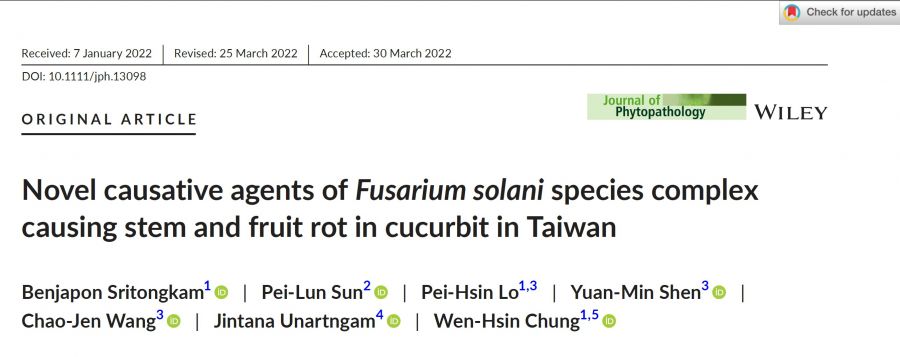新穎材料農業:農業新穎材料在植物保健開發、應用與機理【植物病理學系/鍾文鑫教授】
| 論文篇名 | 英文:Novel causative agents of Fusarium solani species complex causing stem and fruit rot in cucurbit in Taiwan 中文:臺灣引起瓜類莖腐與果腐之新Fusarium solani複合種 |
| 期刊名稱 | JOURNAL OF PHYTOPATHOLOGY |
| 發表年份,卷數,起迄頁數 | 2022, 170, 462-478 |
| 作者 | Sritongkam, Benjapon; Sun, Pei-Lun; Lo, Pei-Hsin; Shen, Yuan-Min; Wang, Chao-Jen; Unartngam, Jintana; Chung, Wen-Hsin(鍾文鑫)* |
| DOI | 10.1111/jph.13098 |
| 中文摘要 | 有四種Fusarium solani 複合種(FSSC),包含F. cucubiticola、F. petroliphilum、F. falciforme及F. keratoplasticum,可以引起瓜類產生基腐、冠腐、莖腐及果腐等病徵。雖前人研究曾指出,F. cucubiticola是引起臺灣甜瓜的冠腐與果腐的病原,但仍無法真實釐清FSSC在臺灣瓜類的種類。本研究自發生莖腐與果腐病徵之苦瓜、胡瓜、絲瓜、甜瓜及南瓜蒐集47株FSSC菌株和3株來自南瓜種子的FSSC菌株。接種結果顯示,來自南瓜果腐的11株菌株與來自南瓜種子的2株菌株,不能感染瓜類幼苗。在所接種的瓜類幼苗中以絲瓜幼苗對供試FSSC菌株最具抗性。於果實接種結果指出,供試FSSC菌株無法感染胡瓜果實,但對其他瓜類果實感染程度不同;此外,只有部份FSSC菌株可被F. cucurbiticola與F. petroliphilum專一性引起對增幅。多基因型分析結果得知,所蒐集FSSC菌株可被分成3個分子群,分別為F. petroliphilum (FSSC 1)群、F. solani-melongenae (FSSC 21)群及F. falciforme (FSSC 3+4)群。其中F. petroliphilum群的菌株皆可被專一性引起對增幅。雖本研究所蒐集菌株中有部份FSSC菌株,可被F. cucurbiticola專一性引子對增幅,但不屬於F. cucurbiticola。依本研究結果,證實上述三種FSSC種類為臺灣新記錄種。 |
| 英文摘要 | Four members of Fusarium solani species complex (FSSC), F. cucurbiticola, F. petroliphilum, F. falciforme and F. keratoplasticum, cause foot, crown, stem and fruit rot in cucurbits. Although previous studies revealed that F. cucurbiticola was the pathogen causing crown and fruit rot in Taiwan melons, these are unreliable in assessing FSSC infection in cucurbits in Taiwan. We collected 47 FSSC isolates from the stem or fruit rot of bitter gourd, cucumber, luffa, melon and pumpkin, and three FSSC isolates from pumpkin seeds. Eleven pumpkin fruit rot isolates and two pumpkin seed isolates could not infect cucurbit seedlings. Luffa seedlings were tolerant to most FSSC isolates. None of the FSSC isolates could infect cucumber fruits and showed variable virulence in different cucurbit fruits. In addition, only certain FSSC isolates could be amplified by specific primers for F. cucurbiticola and F. petroliphilum. Multilocus sequence typing analyses separated FSSC isolates from the stem or fruit rot or seeds into three molecular groups with high bootstrap values: Group I isolates were F. petroliphilum (FSSC1), Group II isolates were F. solani-melongenae (FSSC 21) and Group III isolates were F. falciforme (FSSC 3+4). The FSSC isolates amplified by specific primers for race 2 belonged to F. petroliphilum; however, the FSSC isolates amplified by specific primers for race 1 were not F. cucurbiticola. To our knowledge, the three species of the FSSC are novel causative agents in Taiwan. |
| 發表成果與本中心研究主題相關性 | 為開發可進行永續農業策略之前,了解病蟲害種類是必要手段,即了解敵人是誰才可擬定有效防治方法。本研究確定引起臺灣瓜類莖腐與果腐之病原屬為Fusarium solani複合種中的三種病原,分別為F. petroliphilum、 F. solani-melongenae及F. falciforme,目前己針對此三種病原篩選可防治該類病害之益生菌,期望能有效降低田間病害發生,並減少化學藥的使用,以達永續農業願景。 |







